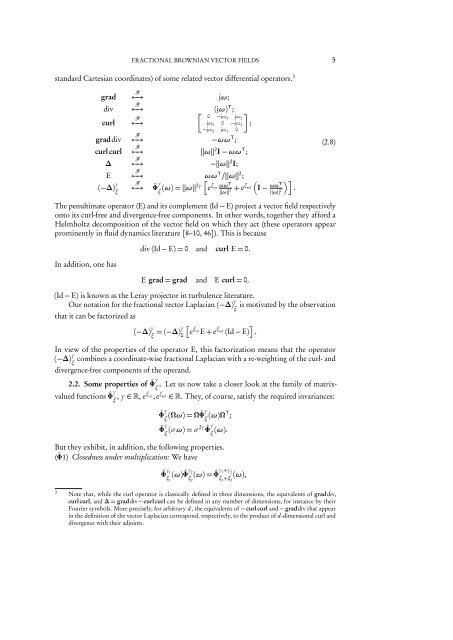FRACTIONAL BROWNIAN VECTOR FIELDS 1. Introduction. A one ...
FRACTIONAL BROWNIAN VECTOR FIELDS 1. Introduction. A one ...
FRACTIONAL BROWNIAN VECTOR FIELDS 1. Introduction. A one ...
You also want an ePaper? Increase the reach of your titles
YUMPU automatically turns print PDFs into web optimized ePapers that Google loves.
<strong>FRACTIONAL</strong> <strong>BROWNIAN</strong> <strong>VECTOR</strong> <strong>FIELDS</strong> 5<br />
standard Cartesian coordinates) of some related vector differential operators. 3<br />
grad<br />
div<br />
curl<br />
graddiv<br />
curlcurl<br />
∆<br />
E<br />
(−∆) γ ξ<br />
<br />
←→<br />
<br />
jω;<br />
←→ (jω) T ;<br />
<br />
←→<br />
<br />
0 −jω3 jω 2<br />
jω 3 0 −jω 1<br />
−jω 2 jω 1 0<br />
←→ −ωω T ;<br />
<br />
←→ ‖ω‖ 2 I − ωω T ;<br />
<br />
←→ −‖ω‖ 2 I;<br />
<br />
<br />
;<br />
←→ ωω T /‖ω‖ 2 ;<br />
<br />
←→ ˆΦ<br />
<br />
γ<br />
(ω) = ξ ‖ω‖2γ e ξ irr ωωT + e ξ ‖ω‖ 2 sol<br />
I − ωωT<br />
‖ω‖ 2 <br />
.<br />
(2.8)<br />
The penultimate operator (E) and its complement (Id − E) project a vector field respectively<br />
onto its curl-free and divergence-free comp<strong>one</strong>nts. In other words, together they afford a<br />
Helmholtz decomposition of the vector field on which they act (these operators appear<br />
prominently in fluid dynamics literature [8–10, 46]). This is because<br />
In addition, <strong>one</strong> has<br />
div (Id − E) = 0 and curl E = 0.<br />
E grad = grad and E curl = 0.<br />
(Id − E) is known as the Leray projector in turbulence literature.<br />
Our notation for the fractional vector Laplacian (−∆) γ is motivated by the observation<br />
ξ<br />
that it can be factorized as<br />
(−∆) γ ξ = (−∆)γ 0<br />
<br />
e<br />
ξ irrE + e<br />
ξ sol (Id − E)<br />
<br />
.<br />
In view of the properties of the operator E, this factorization means that the operator<br />
(−∆) γ combines a coordinate-wise fractional Laplacian with a re-weighting of the curl- and<br />
ξ<br />
divergence-free comp<strong>one</strong>nts of the operand.<br />
2.2. Some properties of ˆΦ γ . Let us now take a closer look at the family of matrixvalued<br />
functions ˆΦ γ , γ ∈ , ξ eξ irr ,e<br />
ξ<br />
ξ sol ∈ . They, of course, satisfy the required invariances:<br />
ˆΦ γ ξ (Ωω) = ΩˆΦ γ ξ (ω)ΩT ;<br />
ˆΦ γ ξ (σω) = σ 2γ ˆΦγ<br />
ξ (ω).<br />
But they exhibit, in addition, the following properties.<br />
(ˆΦ1) Closedness under multiplication: We have<br />
ˆΦ γ 1<br />
ξ 1<br />
(ω)ˆΦ γ 2<br />
ξ 2<br />
(ω) = ˆΦ γ 1 +γ 2<br />
ξ 1 +ξ 2<br />
(ω),<br />
3 Note that, while the curl operator is classically defined in three dimensions, the equivalents of graddiv,<br />
curlcurl, and ∆ = graddiv−curlcurl can be defined in any number of dimensions, for instance by their<br />
Fourier symbols. More precisely, for arbitrary d, the equivalents of −curlcurl and −graddiv that appear<br />
in the definition of the vector Laplacian correspond, respectively, to the product of d-dimensional curl and<br />
divergence with their adjoints.
















